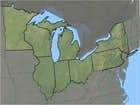U.S. Environmental Protection Agency Administrator Lisa P. Jackson has released an action plan to guide the Obama Administration’s efforts to restore the Great Lakes. The action plan, which the administrator unveiled at a Sunday meeting with governors from the Great Lakes states, lays out the most urgent threats facing the Great Lakes and sets out goals, objectives and key actions over the next five years to help restore the lakes.
“We have an historic opportunity to restore and protect these waters,” Jackson said. “This action plan outlines our strategy to protect the environmental, human health and economic interests of the millions of people who rely on the Great Lakes. We’re committed to creating a new standard of care that will leave the Great Lakes better for the next generation.”
“The Great Lakes are our region’s greatest natural resource, and I want to thank President Obama for his commitment to making the restoration of the Great Lakes a national priority,” said Wisconsin Gov. Jim Doyle, co-chair of the Council of Great Lakes Governors. “Wisconsin is defined by the Great Lakes, and one of our greatest responsibilities is to preserve this important freshwater resource for future generations. This action plan sets a strong course of action as we confront tremendous challenges to not only protect, but also restore the Great Lakes.”
“The Great Lakes are one of our country’s greatest natural resources and economic assets,” said Ohio Gov. Ted Strickland, co-chair of the Council of Great Lakes Governors. “We must protect and preserve our lakes for our families and outdoors enthusiasts, as well as the industries that rely on the waterways to transport their goods around the world. I look forward to working with my fellow governors and the Obama Administration to continue tackling the challenges facing the Great Lakes now and in the future.”
Some 30 million Americans get their drinking water from the Great Lakes, and the lakes also support a multi-billion dollar economy based on fishing, boating and recreational activities. The lakes face significant challenges, including pollution and the threat of harmful species that threaten their health.
President Barack Obama has committed to making Great Lakes restoration a national priority. In February 2009, President Obama proposed $475 million for a Great Lakes Restoration Initiative, the most significant investment in the Great Lakes in two decades. The action plan, which covers FY 2010 through 2014 and was developed by 16 federal agencies as part of the federal inter-agency task force chaired by Jackson, will help guide the administration’s efforts to implement this initiative.
The action plan directs aggressive action under five priority “focus areas” the task force has identified as vital for restoring the Great Lakes. They are:
• Protection and cleanup of the most polluted areas in the lakes;
• Combating invasive species;
• Protection of high priority watersheds and reduced runoff from urban, suburban and, agricultural sources;
• Restoration of wetlands and other habitats; and
• Implementation of accountability measures, learning initiatives, outreach and strategic partnerships.
Source: U.S. EPA


